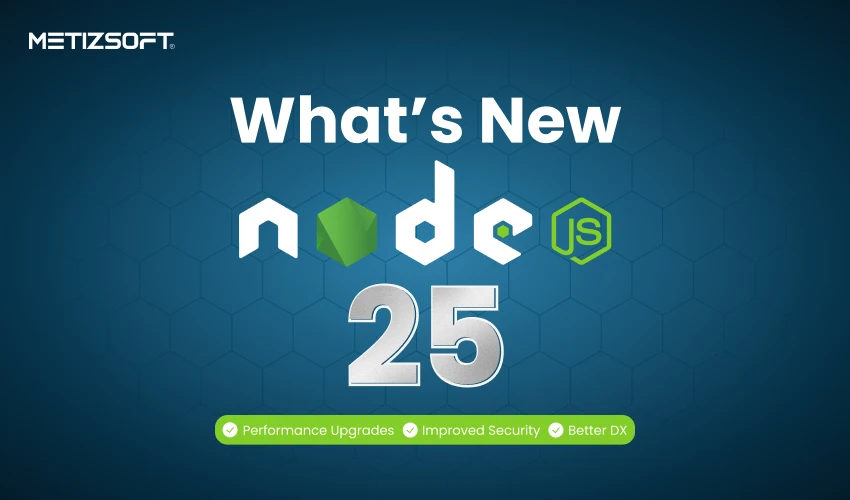
The launch of Node.js 25 has set a new standard for speed, security, and developer productivity. The major enhancements are the next-gen V8 engine for the latest JavaScript support, easier API management, better web compatibility, and more effortless upgrades for both developers and enterprises.
Table of Contents
Introduction
October 15, 2025, marks another promising Node.js version release. The list of exciting upgrades for the developers and the industries implementing them is long. If you are not just a Node.js user but an enthusiastic one, you must have realized by now that every new version is crafted solely for developers. This time, it has also maintained the streak of faster performance, stronger security, and a runtime that works more efficiently for modern applications.
The next LTS is scheduled to be launched in October 2026, giving us 1 year to explore what’s new in Node.js 25 and see how its updated features and functionalities can make your applications more innovative, reliable, and faster.
Node.js 25 Latest Features and Functionalities
Node.js V25 has brought many new features and improvements that make programs run better, help developers work more efficiently, and improve application performance. Here’s a list of Node.js 25 features and improvements that you need to be aware of to make teh most out of the newest version:
1. V8 Engine Upgrade: Quicker and Updated JavaScript
The first notable improvement in Node.js V25 is the update to the V8 engine. The V8 engine version 14.1 adds support for the latest JavaScript features, improving its performance. Now, your JavaScript code will run quickly, especially when you are dealing with big JSON files and complex calculations.
Meanwhile, your Node.js developers will experience better performance when working with large arrays, objects, and tasks that require extensive calculations. On top of that, this version has improved support for modern programming features, such as logical assignment operators, private class fields, and optional chaining.
Example:
const largeArray = Array.from({ length: 1_000_000 }, (_, i) => i); console.time('strigify');
JSON.stringify(largeArray);
console.timeend('stringify');
class Foo {
#privateField = 42;
getValue() { return this.#privateField; }
}
console.log(new Foo().value); //422. Better Handling of Binary Data for Uint8Array
The better management of binary data with Uint8Array is another significant update that has caught developers’ attention. It introduces a new way to make it simpler to change data into base64 or hex formats without needing extra libraries.
This is particularly helpful for apps that deal with buffers, network communications, encryption, and handling files. These changes make the code easier to understand and speed up tasks that need a lot of memory.
Example:
const buf = new Uint8Array([0xDE, 0xAD, 0xBE, 0xEF]);
console.log(buf.toString('base64')); // "3q2+/w=="
console.log(buf.toString('hex')); // "deadbeef"3. Phasing Out Old APIs
The developers of Node.js 25 have been hoping for a significant update to finally eliminate the legacy APIs that have been their primary concern. The main modules, which used callback functions, are now moving away from the old ways and introducing promise-based versions, thus cleaning up the code and making it easier to handle. The async/await pattern could be used by developers after this change.
Example:
//
Legacy callback style
require('fs').readFile('file.txt', (err, data) => {
if (err) throw err;
console.log(data.toString());
});
// Modern Promise-based style
import { promises as fsPromises } from 'fs';
fsPromises.readFile('file.txt', 'utf8')
.then(data => console.log(data))
.catch(err => console.error(err));4. Improved Web APIs
Node.js 25 comes with another important improvement in Web APIs that makes server-side more like what browsers use. The main improvements in the new Web APIs include Web storage, ErrorEvent, and global space changes, which help in reducing code for both client and server setup.
The developers who make the most of these updates may easily adopt more common practices, reduce polyfills, and make cross-platform development more consistent. Moreover, it enables the creation of intelligent Node.js applications compatible with today’s frontend frameworks.
Example:
// Utilizing Web Storage API
global.localStorage.setItem('theme','dark'); console.log(global.localStorage.getItem('theme')); // "dark"
// Controlling errors through ErrorEvent
addEventListener('error', event => {
console.error('Captured error event:', event.error);
});5. Greater Runtime Safety and Reliability
Node.js 25 brings overall improvements for safety during runtime, which means it manages memory more efficiently, reduces the chances of problems, and handles multiple tasks better at the same time. Additionally, your Node.js applications can benefit from a more reliable runtime setting. Also, it can manage heavy workloads and complex tasks running at the same time more reliably and effectively..
Example:
import { performance } from 'perf_hooks';
const start = performance.now();
// Run heavy workload here
const elapsed = performance.now() - start;
console.log(`Workload execution time: ${elapsed.toFixed(2)} ms`);6. Less Internal Work and Shorter Startup Time
There are also changes in Node.js V25 that make it start up faster and use fewer internal resources. Thanks for the change. It will help serverless setups, command-line tools, and microservices that need to start up or run quickly.
By reducing startup time, apps can launch more quickly, and resources used during runtime are more efficient. This gives developers and operations teams an easy way to see how performance changes before and after an upgrade.
Example:
# Measure startup time for your Node.js application: node index.js7. Updates to Core Modules (crypto, fs, http)
Another important change in the Node.js 25 version is the upgrade of various key modules like crypto, fs, and http to make them work better and be safer. These upgrades help developers create safe and fast applications without needing to use outside tools.
For example, the crypto module now has better algorithms and settings that boost security. The fs and http modules have been improved to handle large file transfers and Internet requests more effectively.
Example:
import { createHash, randomBytes } from 'crypto';
const hash = createHash('sha256').update('importantData').digest('hex');
console.log(hash);
const key = randomBytes(32);
console.log(key.toString('hex'));Node.js 25 vs Node.js 24: Notable Changes Comparison
| Features | Node.js 25 | Node.js 24 |
| V8 Engine Versions | V14.1 | V13.6 |
| Permission Model | Gains – allow net for better network management | Stable with –permission |
| Web Storage | Enabled by default | Opt-in, Experimental |
| Test Runner | Has the same upgrades as Node.js 24 | More intelligent, up to 40% quicker than v20 |
| Security | Improved TLS handling, trails version | TLS upgrades and basic fixes |
| NPM | Support NPM v11 | Works well with NPM v11 and V10 |
| Use Cases | For early users, projects that want the latest speed and features. | Stable, ready for production, LTS support |
| Outdated API Removal | More old features, such as SlowBuffer, have been removed. | Old APIs deleted |
How to Upgrade to Node.js V25? A Step-by-Step Guide
When you move to Node.js 25, make sure everything works well, especially on large projects. Here is an easy guide for upgrading to Node.js 25:
Step 1: Install Node.js 25
You have two choices for this: you can use a Node.js version manager to install it safely and flexibly, or you can go to the official website and download the newest version.
# Using nvm
nvm install 25
nvm use 25
node -vAnother tool that can help you deal with different Node versions is “n,” which you can also use:
# Using n
sudo n 25
node -vUse this command to confirm that Node.js 25 is installed correctly:
console.log('Node.js 25 is running');Step 2: Test Core Functionality
Once you have installed it, make sure to check that your apps are working with Node.js 25. You can begin by:
- Testing primary modules like fs, http, crypto, and stream.
- Running simple scripts to check the stability of the runtime.
- Validating any custom scripts or server processes for errors/ warnings.
Step 3: Put Testing Plans to Action
You must perform thorough tests to help the upgrade go well:
- Unit Testing: Check each function, module, and class separately. Pay attention to any strange behavior that may occur due to updates in Node.js 25.
- Integration Testing: Examine API endpoints, how the database works, and connections to outside services to make sure everything still works as it should.
- Regression Testing: Verify that every feature currently in place continues to work, and that 25 can be automated as intended. Finding subtle differences between Node.js 24 and Node.js 25 can be aided by using automatic testing software.
Step 4: Verifying and Observing Following an Upgrade
Keep an eye on your applications’ performance as you start using Node.js 25:
- Watch the CPU and memory usage to identify any areas that are running slowly.
- Check how quickly they respond to see if there are any performance issues.
- Turned on detailed logging and error messages to spot problems while they happen.
You can also hire Node.js developers or reach out to a Node.js service provider for seamless upgrades.
Final Thoughts
Node.js 25 brings notable improvements in each update, helping enterprises build scalable web and application infrastructure. This time, improvements in runtime performance, support for modern JavaScript, and enhanced security make Node.js 25 a strong choice for modern applications. The update makes sure that applications remain reliable and easy to manage as projects evolve.
As a leading Node.js development company, Metizsoft assists companies in preparing for and executing smooth transitions to Node.js 25. Our dedicated experts prepare a structured installation and development roadmap for your modern Node.js application to take full advantage of recent improvements in the runtime.
FAQs
Before updating to Node.js 25, what should I check?
Test the application’s main components, assess startup times, and perform comprehensive integration and regression testing. Following the upgrade, keep an eye on system resources and error logs to guarantee stability and identify problems early.
Why should businesses switch to Node.js 25?
Node.js 25 is advantageous for enterprises because of its enhanced security features, faster runtime with the updated V8 engine, and scalability for handling high concurrent loads.
What is the impact of Node.js 25’s enhanced Web APIs on cross-platform development?
By bringing Node.js closer to browser environments, they reduce the need for polyfills and make code sharing between clients and servers easier.
Can the performance of serverless functions be enhanced by Node.js 25?
Yes, Node.js 25 is better suited to rapidly growing serverless environments and microservices due to its shorter startup times and reduced internal workload.
AboutManthan Bhavsar
Related Posts
The Must-Check Checklist For Hiring The Best Ruby on Rails Developer
Ruby on Rails is acclaimed as a popular web development framework used widely for building web apps. It is particularly...
7 Simple Tips for the Optimization of WordPress Website
The foremost decision that you need to take while creating a fresh website is about the choice of the best Content Management...
